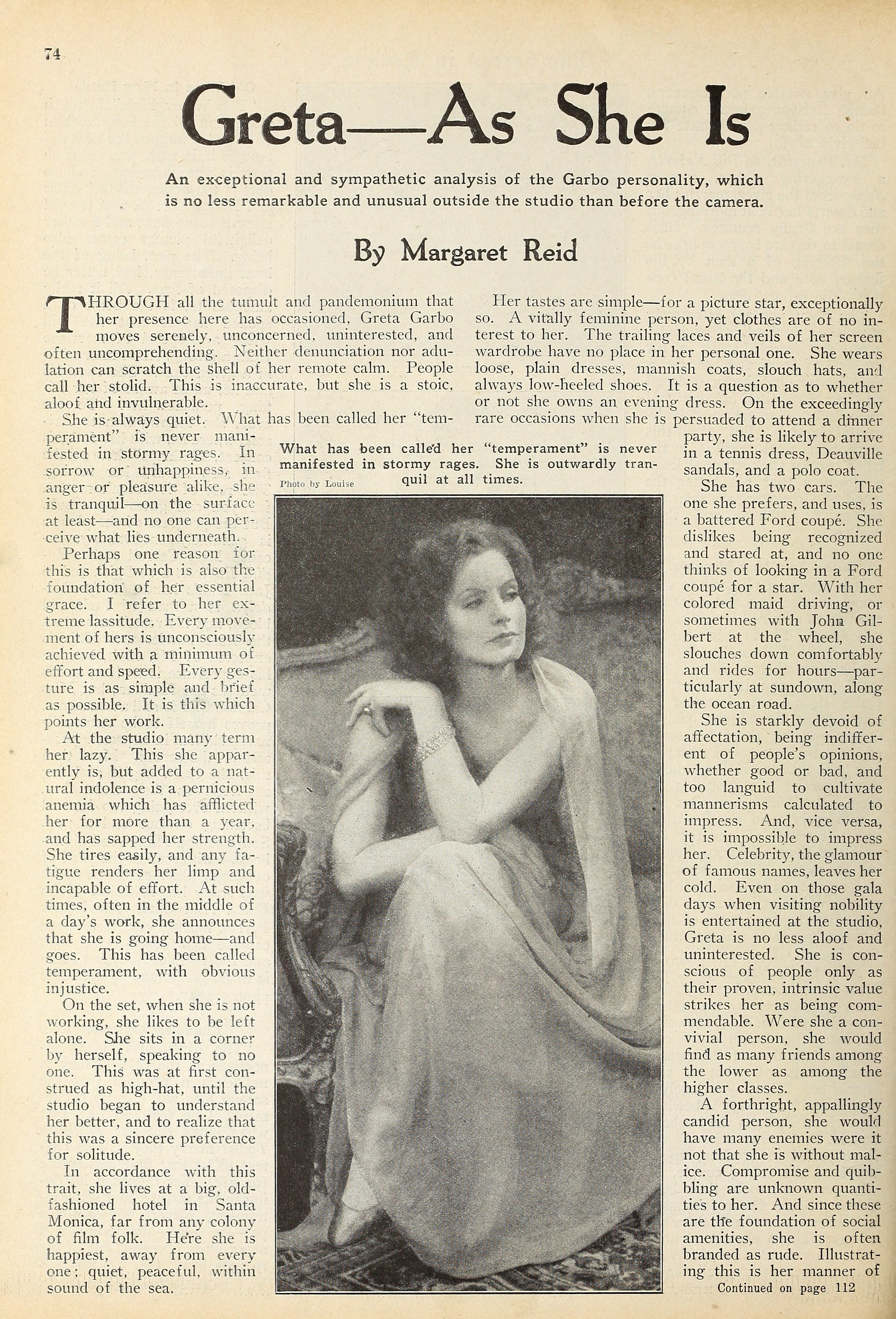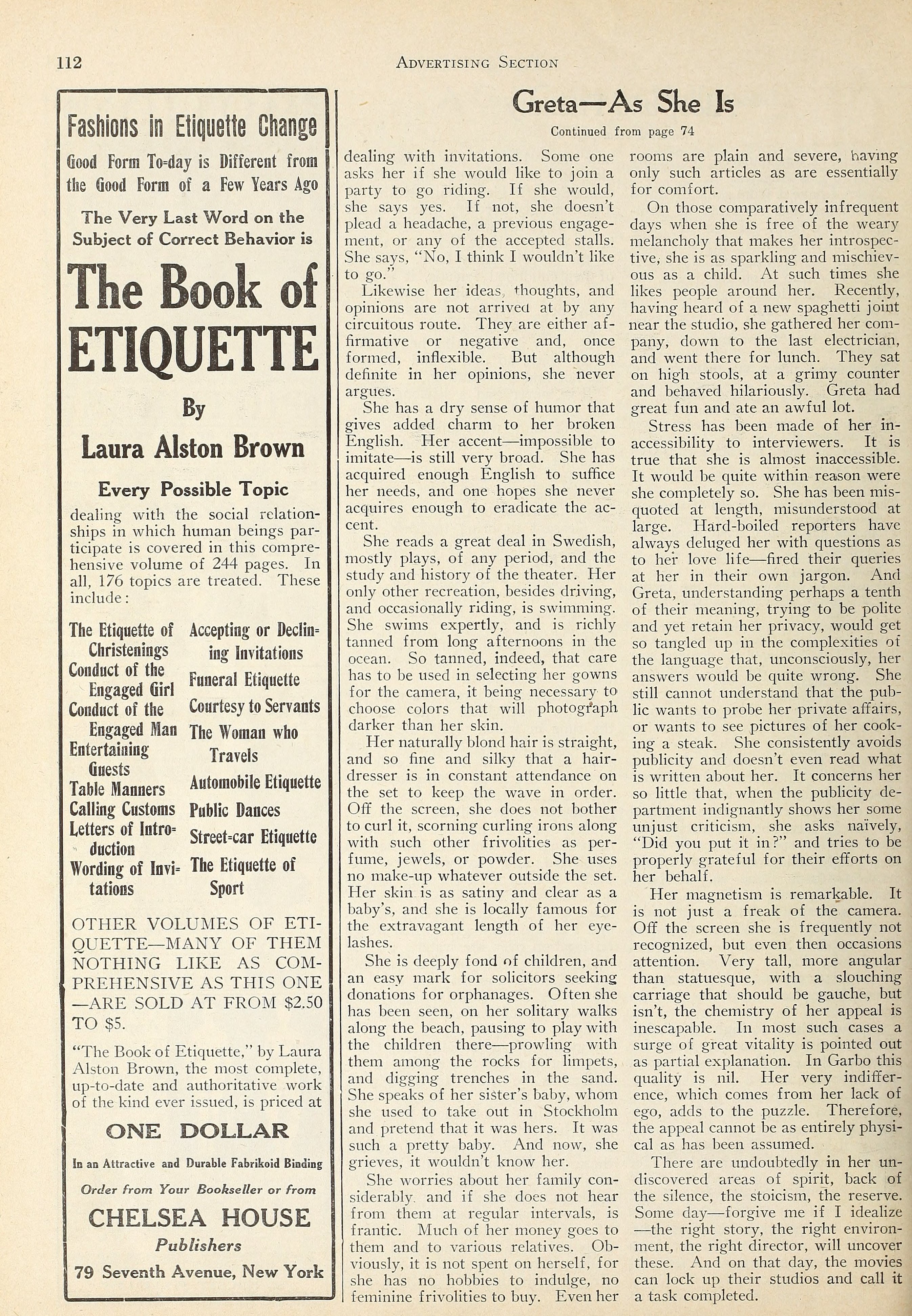Greta Garbo — As She Is (1928) 🇺🇸

Through all the tumult and pandemonium that her presence here has occasioned, Greta Garbo moves serenely, unconcerned, uninterested, and often uncomprehending. Neither denunciation nor adulation can scratch the shell of her remote calm. People call her stolid. This is inaccurate, but she is a stoic, aloof and invulnerable.
by Margaret Reid
She is always quiet. What has been called her “temperament” is never manifested in stormy rages. In sorrow or; unhappiness, in anger or pleasure alike, she is tranquil — on the surface at least — and no one can perceive what lies underneath.
Perhaps one reason for this is that which is also the foundation of her essential grace. I refer to her extreme lassitude. Every movement of hers is unconsciously achieved with a minimum of effort and speed. Every gesture is as simple and brief as possible. It is this which points her work.
At the studio many term her lazy. This she apparently is, but added to a natural indolence is a pernicious anemia which has afflicted her for more than a year, and has sapped her strength. She tires easily, and any fatigue renders her limp and incapable of effort. At such times, often in the middle of a day’s work, she announces that she is going home — and goes. This has been called temperament, with obvious injustice.
On the set, when she is not working, she likes to be left alone. She sits in a corner by herself, speaking to no one. This was at first construed as high-hat, until the studio began to understand her better, and to realize that this was a sincere preference for solitude.
In accordance with this trait, she lives at a big, old-fashioned hotel in Santa Monica, far from any colony of film folk. Here she is happiest, away from every one; quiet, peaceful, within sound of the sea.
Her tastes are simple — for a picture star, exceptionally so. A vitally feminine person, yet clothes are of no interest to her. The trailing laces and veils of her screen wardrobe have no place in her personal one. She wears loose, plain dresses, mannish coats, slouch hats, and always low-heeled shoes. It is a question as to whether or not she owns an evening dress. On the exceedingly rare occasions when she is persuaded to attend a dinner party, she is likely to arrive in a tennis dress, Deauville sandals, and a polo coat.
She has two cars. The one she prefers, and uses, is a battered Ford coupe. She dislikes being recognized and stared at, and no one thinks of looking in a Ford coupe for a star. With her colored maid driving, or sometimes with John Gilbert at the wheel, she slouches down comfortably and rides for hours — particularly at sundown, along the ocean road.
She is starkly devoid of affectation, being indifferent of people’s opinions, whether good or bad, and too languid to cultivate mannerisms calculated to impress. And, vice versa, it is impossible to impress her. Celebrity, the glamour of famous names, leaves her cold. Even on those gala days when visiting nobility is entertained at the studio, Greta is no less aloof and uninterested. She is conscious of people only as their proven, intrinsic value strikes her as being commendable. Were she a convivial person, she would find as many friends among the lower as among the higher classes.
A forthright, appallingly candid person, she would have many enemies were it not that she is without malice. Compromise and quibbling are unknown quantities to her. And since these are the foundation of social amenities, she is often branded as rude. Illustrating this is her manner of dealing with invitations. Some one asks her if she would like to join a party to go riding. If she would, she says yes. If not, she doesn’t plead a headache, a previous engagement, or any of the accepted stalls. She says, “No, I think I wouldn’t like to go.”
Likewise her ideas, thoughts, and opinions are not arrived at by any circuitous route. They are either affirmative or negative and, once formed, inflexible. But although definite in her opinions, she never argues.
She has a dry sense of humor that gives added charm to her broken English. Her accent — impossible to imitate — is still very broad. She has acquired enough English to suffice her needs, and one hopes she never acquires enough to eradicate the accent.
She reads a great deal in Swedish, mostly plays, of any period, and the study and history of the theater. Her only other recreation, besides driving, and occasionally riding, is swimming. She swims expertly, and is richly tanned from long afternoons in the ocean. So tanned, indeed, that care has to be used in selecting her gowns for the camera, it being necessary to choose colors that will photograph darker than her skin.
Her naturally blond hair is straight, and so fine and silky that a hairdresser is in constant attendance on the set to keep the wave in order. Off the screen, she does not bother to curl it, scorning curling irons along with such other frivolities as perfume, jewels, or powder. She vises no make-up whatever outside the set. Her skin is as satiny and clear as a baby’s, and she is locally famous for the extravagant length of her eyelashes.
She is deeply fond of children, and an easy mark for solicitors seeking donations for orphanages. Often she has been seen, on her solitary walks along the beach, pausing to play with the children there- — prowling with them among the rocks for limpets, and digging trenches in the sand. She speaks of her sister’s baby, whom she used to take out in Stockholm and pretend that it was hers. It was such a pretty baby. And now, she grieves, it wouldn’t know her.
She worries about her family considerably, and if she does not hear from them at regular intervals, is frantic. Much of her money goes to them and to various relatives. Obviously, it is not spent on herself, for she has no hobbies to indulge, no feminine frivolities to buy. Even her rooms are plain and severe, only such articles as are essentially for comfort.
On those comparatively infrequent days when she is free of the weary melancholy that makes her introspective, she is as sparkling and mischievous as a child. At such times she likes people around her. Recently, having heard of a new spaghetti joint near the studio, she gathered her company, down to the last electrician, and went there for lunch. They sat on high stools, at a grimy counter and behaved hilariously. Greta had great fun and ate an awful lot.
Stress has been made of her inaccessibility to interviewers. It is true that she is almost inaccessible. It would be quite within reason were she completely so. She has been misquoted at length, misunderstood at large. Hard-boiled reporters have always deluged her with questions as to her love life — fired their queries at her in their own jargon. And Greta, understanding perhaps a tenth of their meaning, trying to be polite and yet retain her privacy, would get so tangled up in the complexities of the language that, unconsciously, her answers would be quite wrong. She still cannot understand that the public wants to probe her private affairs, or wants to see pictures of her cooking a steak. She consistently avoids publicity and doesn’t even read what is written about her. It concerns her so little that, when the publicity department indignantly shows her some unjust criticism, she asks naively, “Did you put it in?” and tries to be properly grateful for their efforts on her behalf.
Her magnetism is remarkable. It is not just a freak of the camera. Off the screen she is frequently not recognized, but even then occasions attention. Very tall, more angular than statuesque, with a slouching carriage that should be gauche, but isn’t, the chemistry of her appeal is inescapable. In most such cases a surge of great vitality is pointed out as partial explanation. In Garbo this quality is nil. Her very indifference, which comes from her lack of ego, adds to the puzzle. Therefore, the appeal cannot be as entirely physical as has been assumed.
There are undoubtedly in her undiscovered areas of spirit, back of the silence, the stoicism, the reserve. Some day — forgive me if I idealize — the right story, the right environment, the right director, will uncover these. And on that day, the movies can lock up their studios and call it a task completed.

What has been called her “temperament” is never manifested in stormy rages. She is outwardly tranquil at all times.
Photo by: Ruth Harriet Louise (1903–1940)

Collection: Picture Play Magazine, December 1928
